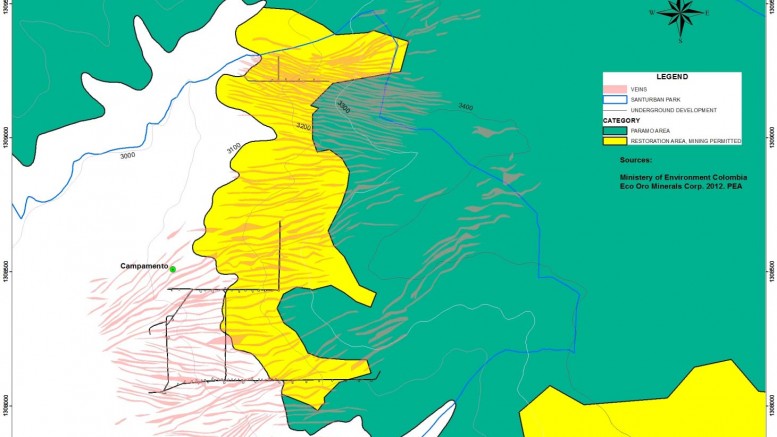Eco Oro Minerals (TSX: EOM) claims the Colombian government has eviscerated its US$250-million investment in the country and is filing for international arbitration.
The Vancouver-based junior has been developing its Angostura gold-silver project in Colombia since the mid-1990s (under its previous moniker Greystar Resources), outlining 3 million oz. gold that it hoped it would extract from an underground mining operation.
Eco Oro president and CEO Mark Moseley-Williams declined to be interviewed about the matter, but the company said in a press release that the dispute involves “arbitrary, inconsistent and disproportionate state measures that have destroyed the value of its investments in the Colombian mining sector.”
The saga apparently began in December 2014, when the national government delineated the paramo of Santurban — a grassland ecosystem found below the snowline and above the treeline in the country’s Andean regions.
According to Eco Oro, the resolution provided that mining could take place in certain areas within the paramo called “mining-permitted restoration areas,” subject to stricter environmental controls.
Eco Oro was “pleased” the government had finally declared the boundaries of the paramo and said that “with the uncertainty relating to the boundaries now out of the way,” management “will proceed with reassessing how the Angostura project will be developed.
“The company’s initial assessment indicates that the Santurban paramo may affect to some limited extent the development of the Angostura deposit, as previously envisioned by the company,” it added. The company stated that its reassessment of how the Angostura project would be developed, given the delineation of the paramo, would include evaluating techno-economic parameters such as cut-off grade, production rates, mining and metallurgical approaches, access to adjacent and at-depth resources and infrastructure layout.
Eco Oro said that it intended the 100%-owned project would “become an exemplary mining and investment project in the area of Santurban.”
After the announcement, Eco Oro directed its technical advisory committee in January 2015 to coordinate an internal technical review to confirm mine capacity, project infrastructure and processing enhancements.
In April 2015, Eco Oro retained Micon International Ltd. to prepare an updated mineral resource on the project to incorporate largely infill drilling that had not been included in the 2012 preliminary economic assessment.
It also retained the services of Chile’s NCL Ingeneria y Construccion S.A. to reassess the project’s underground mine capacity. The study, the company said, would “establish a production rate that is sustainable and contributes to a reduced project footprint, while maintaining optimum levels of potential precious metal production.
Meanwhile, Eco Oro reviewed and prioritized near-deposit exploration targets.
The company completed an updated resource estimate in June 2015 outlining a measured and indicated resource of 2.21 million oz. gold (15.1 million tonnes grading 4.57 grams per tonne) and an inferred resource of 1.03 million oz. gold (6.9 million tonnes averaging 4.70 grams gold per tonne).
The resource was based on information from 1,068 diamond drill holes in 363,000 metres of drilling and used a cut-off grade of 2.5 grams gold per tonne.
The gold and silver deposit — characterized as a structurally controlled high-sulphidation epithermal gold deposit — remains open at depth.
Things looked bad, however, in February 2016, when Colombia’s Constitutional Court ruled that no mining could take place in areas defined as paramo.
In March 2016, Eco Oro notified the government that the court decision contravened the free trade agreement between Canada and Colombia, and that if an acceptable settlement was not reached within six months, it would consider submitting the dispute to international arbitration.
In July 2016, Colombia’s National Mining Agency (NMA) notified Eco Oro that it needed to pay its annual canon on its concession, but that the payment should be made only to 49.3% of the area, because the rest fell within the Santurban paramo preservation area.
This development was followed in August 2016 by news that the NMA had denied the company’s May 2016 application for a two-year extension of the exploration phase of its principal mining title.
The company stated that the resolution “deprives the company of its mining rights in respect of 50.7% of the concession area that falls within the preservation zone of the Santurban paramo.”
The Eco Oro case follows an arbitration notice filed earlier this year by Cosigo Resources (CVE: CSG.H) and Tobie Mining & Energy Incorporated.
In a statement of claim dated Feb. 19, Cosigo and Tobie Mining and Energy said they were seeking international arbitration regarding the “wrongful expropriation made without compensation and based in fraud,” of their Taraira South mining concession in Colombia’s Vaupes department, near the country’s border with Brazil.
The companies say their mining concession “has been inoperable due to the placement” of a national park “over its location,” and are seeking US$16.5 billion in compensation.
In a third case, Glencore (LON: GLEN) submitted a claim against the Colombian government at the International Center for Settlement of Investment Disputes under the 2006 Colombia-Switzerland bilateral investment treaty. The Anglo-Swiss mining giant’s claim revolves around a dispute involving its coal concessions in Colombia.


Be the first to comment on "Eco Oro files for arbitration against Colombian gov’t"